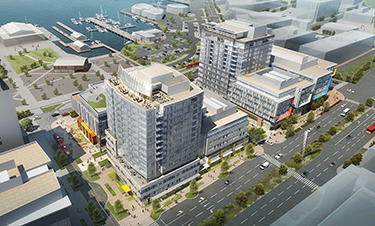|
Subscribe / Renew |
|
|
Contact Us |
|
| ► Subscribe to our Free Weekly Newsletter | |
| home | Welcome, sign in or click here to subscribe. | login |
Construction
| |
 |
May 5, 2017
Survey: GLY Construction
Specialty: High-tech corporate office projects, mixed-use developments; facilities that support health care, life sciences, education and senior living
Management: Jim Karambelas, CEO; Ted Herb, president; Mark Kane, COO; Steve Peterson, CFO
Founded: 1967
Headquarters: Bellevue
2016 revenues: $533 million
Projected 2017 revenues: $537 million
Projects: 74,300-square-foot middle school for Seattle Academy of Arts and Sciences; Two Lincoln Tower luxury apartments in Bellevue for Kemper Development Co.; shell and core of Vulcan’s 1.1 million-square-foot mixed-use development along Mercer Street in Seattle
COO Mark Kane answered questions from the DJC about his firm and issues in the industry.
Q: What are the biggest issues in your industry?
A: How to grow responsibly, while continuing to deliver projects with the nimbleness, cost effectiveness and quality we are accustomed to. Strong technical and relational skills needed to excel are in short supply. We must take on only the work we can responsibly deliver.
Capacity constraints for subcontractors and suppliers, and the availability of experienced, skilled tradespeople are equally tempering our industry’s ability to respond. At the same time, technology greatly leverages our ability to effectively manage complex projects on compressed schedules. To do this we need a highly educated, highly experienced workforce that takes time and great investment to grow. The supply chain to our industry was greatly impacted by the Great Recession and is only now rebounding.
Q: Which sectors are growing and which are slowing?
A: We continue to see strong demand in technology office, urban residential, small and mid-size health care, adaptive re-use, life sciences, lifestyle center related retail and hospitality, and education — in the public and private sectors. Senior living projects are starting to re-emerge locally.
We are starting to see a slowdown in high-rise apartment construction and speculative office development projects without significant pre-leasing. Many major health care projects are stalled by the uncertainty created around government support, and also the ongoing consolidation in their industry.
Q: You have done a number of senior housing projects. What is trending there?
A: The move to aging in place has created an industry in itself — properly supporting people who want to age in the comfort of their own homes. The industry is reorganizing itself around this fundamental change in demographics and desires from this community. We see projects that are deliberately lifestyle focused, with amenities that weren’t widespread previously such as common areas for hobbies and entertainment, exercise and fitness facilities, beauty salons, and more spaces and styles of dining designed to be much more interactive. There is a lot of work now from the companies that are investing in repositioning their facilities to respond to these changing needs.
Q: How are rising land costs in Seattle affecting what gets built?
A: When you look at who occupies new facilities, you see it is only the most successful and forward-thinking organizations that can afford the cost of new construction. The economics around housing projects are more challenging; there aren’t options for multiple income levels and that is a great concern for the growth and sustainability of our region.
Ensuring we can house all who want to live, work and play nearby is essential for sustainable responsible growth. Regional sustainable solutions are available to help combat these challenges, but political will and cooperation are necessary to get moving in the right direction. It was wonderful that ST3 passed and that we are continuing work on the beginnings of a high-quality regional transit system.
Other Stories:
- ABC mantra: Get into politics or get out of business
- Multifamily Construction
- Institutional Construction
- Historic Preservation/Restoration
- Electrical Construction
- Mechanical Construction
- Specialty Contracting: Exterior
- Survey: Stoneway Concrete
- Survey: Colvos Construction
- Survey: Compass General Construction
- Survey: Rafn Co.
- Tenant Improvement/Renovation
- Healthcare
- 10 things developers must consider when hiring a GC
- Tech wizardry: What’s really behind the curtain?
- Time to put the brakes on 700 work zone deaths
- Equipment firms’ new focus: ‘power-by-the-hour’
- What every contractor should know about bonds
- Eagle of Excellence • Mixed-Use Construction
- Commercial Construction over $10 million
- Commercial Construction $1 million to $5 million
- Commercial Construction under $1 million
- Community & Public Service
- Survey: PCL Construction Services



